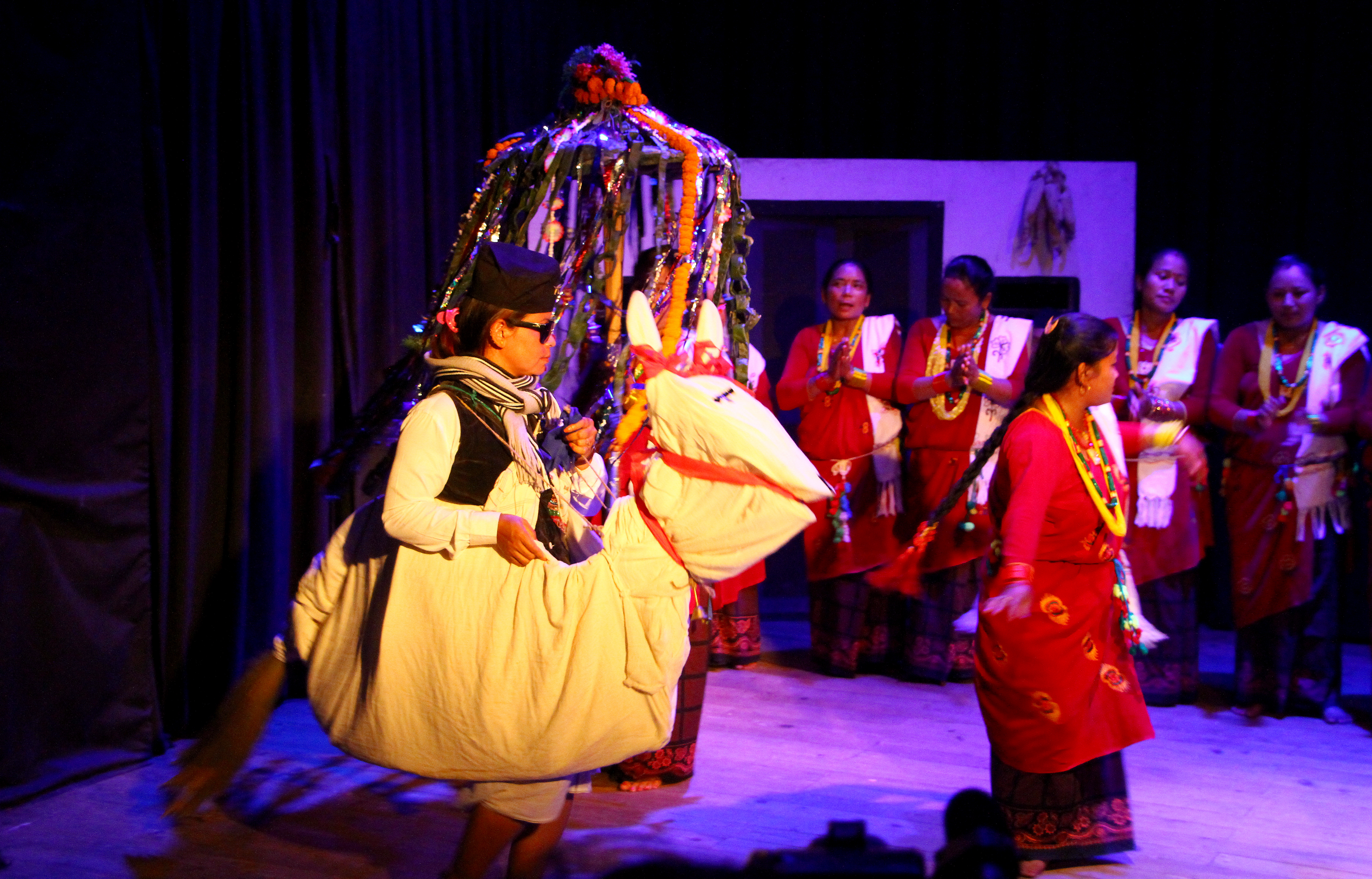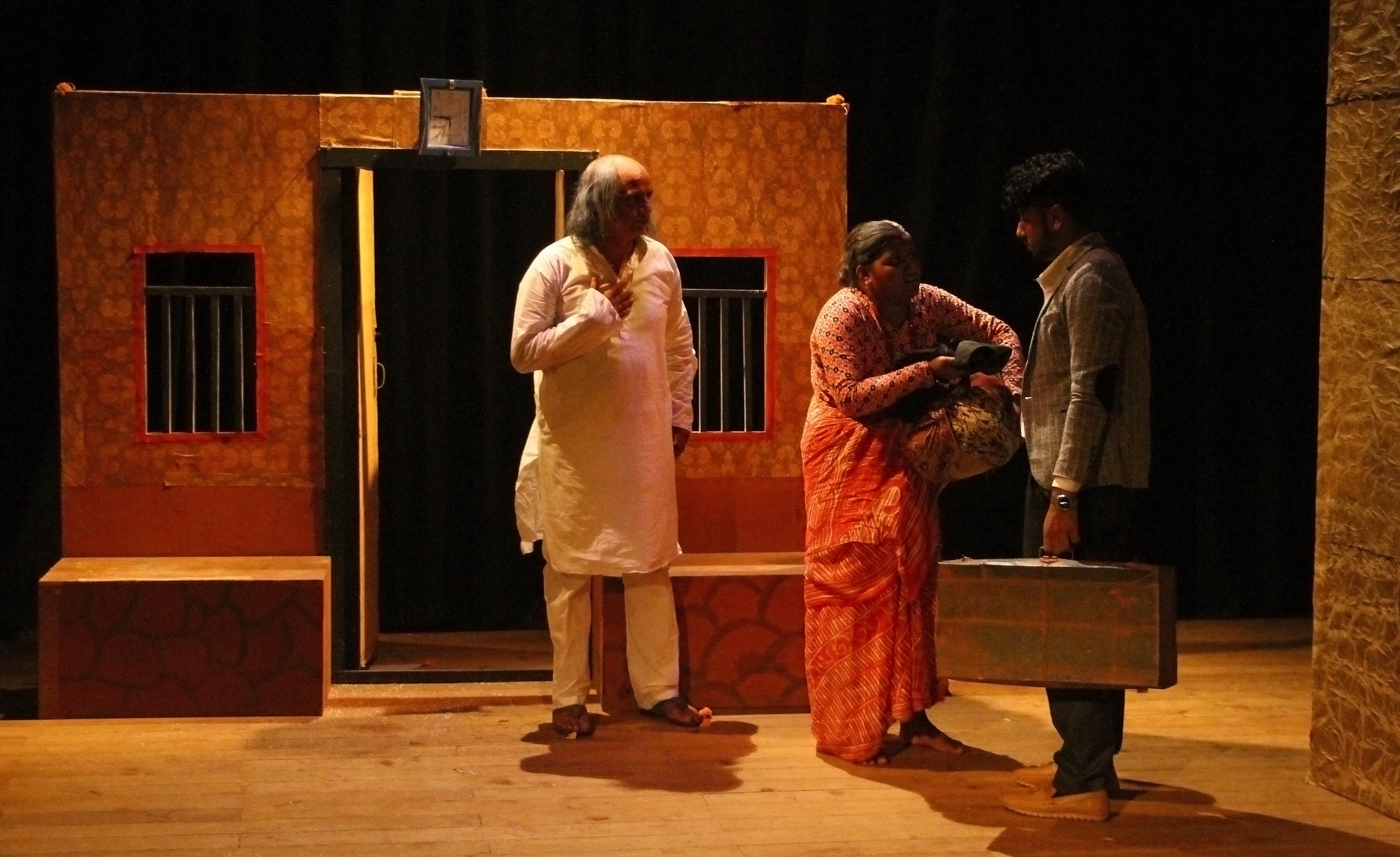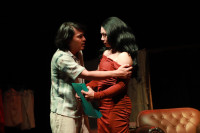Theater
National Theatre Festival could have been a great event—but it fell short
The seven-day long festival tried to be diverse and inclusive—but with limited staging, did it achieve what it set out to do?
Abani Malla
In a courtyard outside a makeshift house, eight Magar women, elegantly dressed in traditional attire—red choli with black fariya, stand opposite each other in two lines, as if mirroring one another. Upon the arrival of the priest called Lama Baje, played by a woman, the two teams begin to perform a Dohori-like musical act in Magar language while rhythmically moving towards the opponent team, making the other team walk backwards as if playing a game of Kabaddi.
This is a scene from the play Jiwaimama Geetinatak, which was performed on the third day of the National Theatre Festival organised by the Nepal Academy of Music and Drama. The scene musically dramatises a character’s (Jayasara) pre-marriage ceremony, in which her cousin’s family have come to request her parents to allow her to marry him, adhering to the culture of marrying maternal cousins, known as ‘mama-cheli marriage’ within Magars.
Bhim Maski Rana, the director of the play, has successfully presented the pre-marriage ceremony and celebration in Magar culture. There were a number of dances performed during the entire play—from Kalash dance, Ghoda dance to Lahure dance. While Kalash and Ghoda dances were a part of the Magar culture since the existence of Baise and Chaubise Rajya—before the unification of Nepal—they incorporated the Lahure dance after many of their men joined the Indian and Singaporean Army.
In the Magar tradition, Jiwaimama is performed at the bride’s house to request her parents for the wedding, from where the theatre troupe Magar Adhyanna Kendra derived the play’s title.
Although the play was rich in terms of its presentation of the cultural wedding ceremony of Magars, the music and dance sequences seemed to overwhelm the overall storytelling in the play. For instance, it was difficult to even understand how the two teams convinced each other for marriage.

But that was the purpose of this theatre festival, says Narayan Bhakta ‘Rayan’ Shrestha, chancellor of Nepal Academy of Music and Drama.
“We wanted to reach out to those drama groups that couldn’t reach to the Academy or the mainstream audience in the capital,” says Shrestha. “So we tried to contact as many drama groups, especially from the villages, as possible and filtered them according to the quality of their script.”
The seven-day long festival was held at the Sarwanam Theatre from June 17 to June 23 to encourage the practice of theatre arts. According to Shrestha, the plays were chosen from each of the seven provinces of Nepal as a vision to include diverse culture, language, and stories.
During Jiwaimama Geetinak, regardless of the language barrier, the audiences were seen immersed in the musical experience. The fourth play of the festival Ghar Bhitrako Arko Ghar, however, despite having a witty screenplay, which was able to engage the audience in parts, lacked in the crisp execution.
Directed by Jiwan Baral of Kshitiz Natya Samuha, the play takes the audience to a rural setting at the beginning of the play and ends by bringing the viewers back to city life. The story written by Bharat Guragain ‘Barbarik’, who also plays the role of Dhanapati, one of the main characters, has the potential to connect the viewers as one could relate to the prevailing popular culture like a young daughter’s addiction to PubG.
The tale is, however, based on a cliche storyline of how a son treats his parents after promising them a luxurious life in the city and ends up shattering their trust.
While the acting and the delivery of dialogues of the cast were notable, the core message of the very first scene failed to catch up later in the play. Guragain’s story didn’t tell anything new: it’s a mix of the same emotions—of discrimination, cheating and betrayal that’s been told countless other times.

Regardless, some of the scenes are powerfully portrayed as when each character realistically expresses their emotions—the audience can feel their pain. But the lights and the props management fail to deliver similar emotions through their presentations. One could see them preparing the stage in blue moonlight and even when done, there would be some remnants of props from previous scenes.
Additionally, with the props and lights not placed well, one of the cardboard walls almost accidentally caught fire during a Tihar scene. Although there weren’t such mishaps in other plays, the stage lighting was a letdown.
Nevertheless, the seven different plays staged at the festival had a different setting, as per the Academy’s intention. But each play was staged only once during the entire festival, limiting its engagement with the wider audience.
According to Shrestha, the reason behind organising a week-long festival without multiple shows was the limited rent period at Sarwanam theatre and ongoing legal conflicts regarding the appointment of Academy members including Shrestha.
“There were some internal problems that made us compromise the length of the festival,” he says.
Perhaps to encourage more public participation, the entry to the festival was free. Nisha Sharma Pokhrel, head of Drama Department at the Academy and a veteran theatre artist, recalls her days at Gurukul and how students couldn’t afford to watch the play due to the ticket rate.
“Ever since then, I’ve felt that theatre should be affordable for everyone,” says Pokhrel. “Especially when organising through the Academy, I believe that it should be free.”
Apart from these two plays, Pampaful by Karnali Theatre ‘Kalakunj’, Ishworlai Chitthi by Kalalaya, Amar Singhko Khojima and Bikash Versus Nikash by Tarang Sanskritik Parisad, and Mita aba kona chalab in Maithali language by Birat Maithil Natya Kala Parisad was staged during the festival.




 20.12°C Kathmandu
20.12°C Kathmandu











